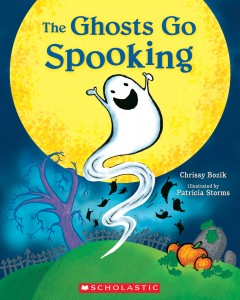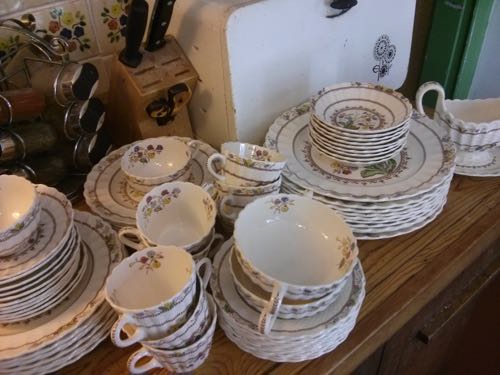October 27, 2015
On Rereading: CNQ 93
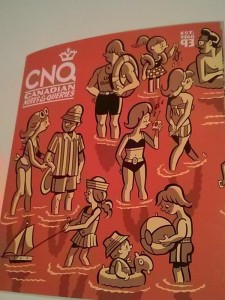 While I wish it were otherwise, the truth is that it’s rare for a magazine to arrive on my doorstep and for me to have devoured the entire thing in a day or two. But then a magazine like Canadian Notes & Queries 93 is a rare thing. Guest-edited by Kim Jernigan, beloved former long-time editor of The New Quarterly, the issue’s focus is on rereading, inspired by the 2005 anthology, Rereadings, edited by Anne Fadiman. And basically once Anne Fadiman turns up on page 7 of your magazine (in Jernigan’s intro: “On Rereading, its Pleasures and Perils”), I’m totally hooked.
While I wish it were otherwise, the truth is that it’s rare for a magazine to arrive on my doorstep and for me to have devoured the entire thing in a day or two. But then a magazine like Canadian Notes & Queries 93 is a rare thing. Guest-edited by Kim Jernigan, beloved former long-time editor of The New Quarterly, the issue’s focus is on rereading, inspired by the 2005 anthology, Rereadings, edited by Anne Fadiman. And basically once Anne Fadiman turns up on page 7 of your magazine (in Jernigan’s intro: “On Rereading, its Pleasures and Perils”), I’m totally hooked.
(I reference Fadiman in my own essay about rereading Fear of Flying; come to think of it, my most recently published essay is about rereading too. It seems that I am the target audience for this issue of CNQ.)
Do you know Anne Fadiman? Oh, but you have to. Her essay collections Ex Libris and At Large and At Small are two of the best books I have ever read. Loving Anne Fadiman’s work is a bit like being in the world’s best secret society, except none of it’s a secret and we want everyone to join.
Anyway, an entire magazine inspired by Anne Fadiman. Think of it. In fact, go out an buy it. To read Caroline Adderson on rereading (and rewriting) her first novel, A History of Forgetting. It’s about missteps, failure, cringeworthy moments, and on what remains: “First this book tortured me, now it’s humbled me.” And Carrie Snyder on reading The Prime of Miss Jean Brodie, which has changed and not changed both in what it has to tell her about being a writer: “It is the book I aspire to write…” And then Anne Marie Todkill on rereading Mrs. Dalloway. Kathy Friedman on Jane Urqhart’s Changing Heaven, which fails to measure up. (A funny aside: recently I spent an evening laughing hysterically with old friends about how strange we all were when we met nearly 20 years ago. One of us had a Jane Urquhart poster on the wall, my friend Kate remembers. This idea now seems absurd: that Urquhart had such cultural currency. I couldn’t believe it. And then not a half hour later, I was looking through an old scrapbook into which I’d etched a quotation from something by Urquhart, from The Whirlpool, maybe. I even now remember that I once wrote a poem inspired by her book, The Underpainter. All of this feels impossible now. Who knew she was such a touchstone?). And then Susan Olding on The Golden Notebook, weaving her read and her reread into a terrific story of learning lessons again and again, about fragmentation and discovery. The ways in which our readings and rereadings can go oh so wrong.
Plus there are three poems by Robyn Sarah, from her collection, My Shoes are Killing Me, which has been nominated for the Governor Generals Prize for Poetry. The kind of poems you read and that have to read aloud to whoever is sitting on the couch beside you. And a story, “Multicoloured Lights,” by Jess Taylor, from her short story collection, Pauls. And book reviews by Emily Donaldson and JC Sutcliffe. It really doesn’t get any better. (There is also work by men in the issue, although those are the ones that I skimmed…)
So go buy it. That’s all. I think it’s available on newsstands now, so go and delight in its goodness, in the worlds these pieces open and reopen, and how the best thing about literature is that we’re never ever though.
October 26, 2015
Good things to know
 Okay, I know it’s not even Halloween, but have you heard about the 2015 Short Story Advent Calendar? It’s better then chocolate (apparently?), 24 stories for readers to open every day leading up until Christmas. Contributors include Pasha Malla, Jess Walter, Heather O’Neill, Richard Van Camp, and Zsuzsi Gartner, and bunch of others whose identities are staying secret (but a few of whom emailed me on the down-low to let know they were involved, leading me to order my calendar. Trust me: you’re going to want to get in on this). Kudos to Michael Hingston and Natalie Olsen for taking the initiative and making it happen.
Okay, I know it’s not even Halloween, but have you heard about the 2015 Short Story Advent Calendar? It’s better then chocolate (apparently?), 24 stories for readers to open every day leading up until Christmas. Contributors include Pasha Malla, Jess Walter, Heather O’Neill, Richard Van Camp, and Zsuzsi Gartner, and bunch of others whose identities are staying secret (but a few of whom emailed me on the down-low to let know they were involved, leading me to order my calendar. Trust me: you’re going to want to get in on this). Kudos to Michael Hingston and Natalie Olsen for taking the initiative and making it happen.
And the reason we’re talking about it now is that the calendar is available as a one-time, limited edition print run. By which I mean: Get it while you can.
Oh, and another thing? Remember the panel I took part in at Quill & Quire about whether we’re living in a golden age of Canadian picture books? It’s now online and you can read our discussion here.
October 23, 2015
The Ghosts Go Spooking, by Chrissy Bozik and Patricia Storms
This week our family has been having fun with The Ghosts Go Spooking, a new picture book written by Chrissy Bozik and illustrated by my friend, Patricia Storms. Sung to the tune of The Ants Go Marching, the story traces the antics as a group of friendly ghosts make the most of Halloween night on their way to a costume party at a haunted house. A nice touch is that the ghosts themselves are costumed—as a clown, a witch, a cowboy. As as they go, one-by-one, two-by-two, etc., one of them (a different one every time—the scary one, the silly one, the wiggly one) stops and does a variety of things—knockings on a door, does a jive, does some tricks.
The story is more fun than scary, which is a good thing with our crowd, and my kids like the mischief the ghosts get up to, their amusing extra-textual dialogue in the illustrations: “Better than a rabbit,” exclaims the Bunny-hopping ghost when “the clever one” conjures bats from his hat. Momentum builds as the ghosts eventually end up spooking ten-by-ten, arriving at their party to find a horn-playing werewolf and a vampire on the double-bass, spooky rock-and-rolling against an enormous yellow moon. No doubt this is a party that will go one well into the night.
Boo boo boo…
October 20, 2015
There’s all this goodness and decency and common sense on the ground
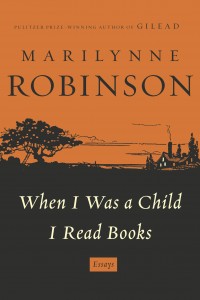 “At present, here in what is still sometimes called our Calvinist civilization, the controversies of liberalism and conservatism come down, as always, to economics. How exclusive is our claim to what we earn, own, inherit?Are the poor among us injured by the difficulties of their lives, or are the better among them braced and stimulated by the pinch of want? Is Edwards undermining morality when he says “it is better to give to several that are not objects of charity, than to send away empty one that is”? Would we be better friends of traditional values, therefore better Christians, if we exploited the coercive potential of need on the one hand and help on the other?…” —Marilynne Robinson, “Open the Hand Wide: Moses and the Origins of American Liberalism.”
“At present, here in what is still sometimes called our Calvinist civilization, the controversies of liberalism and conservatism come down, as always, to economics. How exclusive is our claim to what we earn, own, inherit?Are the poor among us injured by the difficulties of their lives, or are the better among them braced and stimulated by the pinch of want? Is Edwards undermining morality when he says “it is better to give to several that are not objects of charity, than to send away empty one that is”? Would we be better friends of traditional values, therefore better Christians, if we exploited the coercive potential of need on the one hand and help on the other?…” —Marilynne Robinson, “Open the Hand Wide: Moses and the Origins of American Liberalism.”
It’s been fascinating to be reading Marilynne Robinson’s essay collection, When I Was A Child I Read Books, during the last few days. I bought this book at the Victoria College Book Sale at the urging of my friend Kate, though I was wary of it—the religion, the erudition. But then I read President Obama’s interview with Robinson and realized I needed to explore Robinson’s ideas further, particularly as my own country has been standing at a major crossroads. Obama and Robinson’s discussion about “the sinister other,” about democracy, about faith and religion—it all seemed so relevant. I wanted a deeper understanding of where we might be going, and yes, I also wanted that feeling that you get, that whatever else is wrong with the world, at least Marilynne Robinson is in it.
Thankfully, Canadians made a choice against hatred and divisiveness yesterday, and I am so relived that glad that this awful era has ended. Though I know it’s not quite as simple as that—it is indeed a terrifically good time to be non-partisan, but I know many of my friends were pretty devastated to see the NDP garner such enormous losses. There terribleness of the last ten years has only underlined that we have centuries of colonial tragedy to reconcile with. I know that the new Liberal government will have to be held to account on their election promises. And it’s interesting to read the “Open the Hand Wide…” essay from Robinson, on the etymological and political origins of “liberal.”
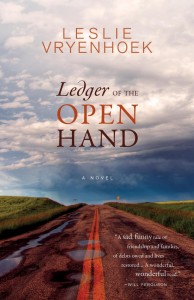 Interesting too to think of Leslie Vryenhoek’s novel, The Ledger of the Open Hand, which I really enjoyed just a few weeks and whose review I began with Marsha Lederman’s line, “Great civilizations aren’t remembered for their tax policies.” This has also been a book that resonates, and is concerned with the same theological issues that Robinson raises in her essay. It’s all very circular.
Interesting too to think of Leslie Vryenhoek’s novel, The Ledger of the Open Hand, which I really enjoyed just a few weeks and whose review I began with Marsha Lederman’s line, “Great civilizations aren’t remembered for their tax policies.” This has also been a book that resonates, and is concerned with the same theological issues that Robinson raises in her essay. It’s all very circular.
And of course it is. Lines from When I Was a Child… have been sticking with me, no matter that the book is indeed a demanding read, requiring patience and concentration. But oh, the rewards. “Imagination and Community” concludes with “The great truth that is too often forgotten is that it is in the nature of people to do good to one another.” I firmly believe this. Monday’s result is a testament to that—a rejection of a vision of the world entrenched in othering, hatred and greed.
So yes, it’s all very circular. Tonight I was reading the latest post at Calm Things, the blog by Shawna Lemay (whose novel arrived in the mail today!). The post is entitled “three small kindnesses.” It seemed in keeping with everything I’ve been thinking about. Lemay writes, “So I’ve been thinking this week about goodness, kindness, compassion, decency.” And naturally, she comes back to the Obama interview with Marilynne Robinson. Obama saying: “And the thing I’ve been struggling with throughout my political career is how do you close the gap. There’s all this goodness and decency and common sense on the ground, and somehow it gets translated into rigid, dogmatic, often mean-spirited politics.”
Sometimes—it’s heartening to see—goodness and decency prevail.
October 18, 2015
Night Moves, by Richard Van Camp
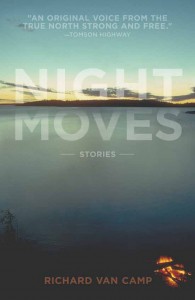 Richard Van Camp’s short story collection Night Moves is a book about transgressions. And for me even reading it was something of a transgression—I don’t read many male writers and Van Camp’s stories are so very male, stories with grit and violence, so much aggression. More than once I wondered if this book was really for me, but something compelled me to keep going. Part of it that these stories weren’t all so male after all, or at least that the question of gender isn’t a straightforward one—the first story, “bornagirl,” is about a trans woman violently assaulted by the young narrator who fears her difference as much as he’s drawn to it. Gender is fluid in many stories throughout the book. And so too are notions of natural and supernatural, the line sometimes blurred entirely to rich and evocative ends, otherworldly creatures living amidst the solidity of the physical world. And stories of otherworldliness living comfortably beside others altogether steeped in realism—”I Double Dogrib Dare You” about a man infatuated by a woman he calls The Holy Woman, a woman said to be half-spirit; followed by “Blood Rides the Wind” about a young man who rides into town intent on revenge for his cousin’s sexual abuse at the hands of a school principal, but who finds his plans challenged by a different kind of blood tie and a promise for the future. “Because of What I Did” is another story of revenge, against a man who’s part of a network behind the disappearance of women across the country—an allusion to the more than a thousand Indigenous women who’ve been murdered or gone missing in Canada in recent decades, to little or no notice until recently. And the very sexy but miraculously restrained “If Only Tonight,” speaking of transgressions, is about a married couple and an old friend, true confessions, no inhibitions and boundaries falling away altogether…as a David Gray winds down on the stereo (of course!).
Richard Van Camp’s short story collection Night Moves is a book about transgressions. And for me even reading it was something of a transgression—I don’t read many male writers and Van Camp’s stories are so very male, stories with grit and violence, so much aggression. More than once I wondered if this book was really for me, but something compelled me to keep going. Part of it that these stories weren’t all so male after all, or at least that the question of gender isn’t a straightforward one—the first story, “bornagirl,” is about a trans woman violently assaulted by the young narrator who fears her difference as much as he’s drawn to it. Gender is fluid in many stories throughout the book. And so too are notions of natural and supernatural, the line sometimes blurred entirely to rich and evocative ends, otherworldly creatures living amidst the solidity of the physical world. And stories of otherworldliness living comfortably beside others altogether steeped in realism—”I Double Dogrib Dare You” about a man infatuated by a woman he calls The Holy Woman, a woman said to be half-spirit; followed by “Blood Rides the Wind” about a young man who rides into town intent on revenge for his cousin’s sexual abuse at the hands of a school principal, but who finds his plans challenged by a different kind of blood tie and a promise for the future. “Because of What I Did” is another story of revenge, against a man who’s part of a network behind the disappearance of women across the country—an allusion to the more than a thousand Indigenous women who’ve been murdered or gone missing in Canada in recent decades, to little or no notice until recently. And the very sexy but miraculously restrained “If Only Tonight,” speaking of transgressions, is about a married couple and an old friend, true confessions, no inhibitions and boundaries falling away altogether…as a David Gray winds down on the stereo (of course!).
Van Camp is a prolific writer and storyteller, a Dogrib (Tlicho) Dene from Fort Smith, Northwest Territories. We know him best in our house from his children’s books (Little You; What’s the Most Beautiful Thing You Know About Horses?), and it’s another transgression, I suppose, that his work so readily moves between audiences and genres. The stories in Night Moves extend the narratives of characters from his previous works, including the novel The Lesser Blessed and his most recent collection, Godless But Loyal to Heaven. (This review by Lauren Scott does a great job of putting Night Moves in the wider context of Van Camp’s work.)
I’m inclined to criticize a certain roughness I encountered editorially—typos and a few mistakes—in my copy of the book (which I think was an ARC). Although there is something about such roughness in keeping with the entire project—this is a book far more about its edges than its polish. It’s a rough book. And yet the “something compelling” I found about it all along, I think, is the way that it’s all the same infused with the power of hopefulness. Like its characters at pivotal moments, standing at the crossroads, the reader is driven to turn a corner, turn the page.*
(*Which is another Bob Seger reference I made totally by accident…)
October 17, 2015
Happy Birthday, Lillian H. Smith, and The Story Project
 Today was the Lillian H. Smith Library’s 20th birthday party, and we rushed down to College Street after Iris’s nap to catch the end of it. The library has been a special part of our family for the last five years—I wrote about it first in 2011 as part of my “Wild Libraries I Have Known” series, and it also came up in my post about Joan Bodger and Mad Men. It’s truly an extraordinary place—we were there for the Crayon Creators event just a few weeks ago, and last summer completely by mistake we stumbled upon an amazing African drumming workshop because that’s the kind of thing that just happens at the Lillian H. Smith Library.
Today was the Lillian H. Smith Library’s 20th birthday party, and we rushed down to College Street after Iris’s nap to catch the end of it. The library has been a special part of our family for the last five years—I wrote about it first in 2011 as part of my “Wild Libraries I Have Known” series, and it also came up in my post about Joan Bodger and Mad Men. It’s truly an extraordinary place—we were there for the Crayon Creators event just a few weeks ago, and last summer completely by mistake we stumbled upon an amazing African drumming workshop because that’s the kind of thing that just happens at the Lillian H. Smith Library.
So we wanted to share in the celebration, and yes, we were told there would be cake. And there was! Plus spring rolls and cups of tea (ala Alice!—“Illustrating Alice” is the exhibit currently on at the Osborne Collection of Early Children’s Books). We were glad to see our beloved Joanne, children’s librarian extraordinaire. There were crafts and face-painting. And the gorgeous bookish birthday table…
Even better? Today was also the launch of the Lillian H. Smith Library Story Project, imagined and brought to reality by the amazing Christina Wong, a library page. Over the summer she collected stories from people with connections to the library, and put them all together on the site. I was happy to share stories about how the library has been so important to my experiences as a mother and our family life in the city: you can listen to it here. (Interestingly, it’s the first time that listening to my voice has not made me want to die… I’m really pleased with how our interview turned out.)
So far I’ve also listened to Andrew Larsen on the role the library has played in his development as a children’s author, and Ken Setterington on the story of Joan Bodger and her husband’s ashes. Looking forward to listening to the rest.
And I’m so happy to have been a part of this project, which celebrates one of my favourite places in the world.
October 14, 2015
Basic Black With Pearls, by Helen Weinzweig, and Nightwatching, by Méira Cook
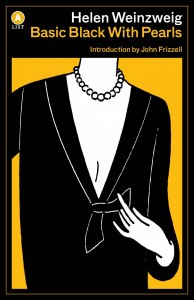 Helen Weinsweig’s “lost feminist classic” Basic Black With Pearls was winner of the Toronto Book Award in 1981, and has been reissued as part of House of Anansi Press’s A List series on the occasion of Weinzweig’s centenary. It’s part of the city’s canon of books about unhinged women and sub-urban ennui, along with Phyllis Brett Young’s The Torontonians and Atwood’s The Edible Woman, although Weinsweig’s novel is far stranger. Its protagonist, Shirley Kaszenbowski, apparently travels the world on false passports, moving from city to city upon the signal of her dubious lover, the mysterious Coenraad, who communicates to her via her codes inside back-issues of National Geographic. This arrangement is disturbed when she finds herself called back to Toronto, the city she grew up in and has fled from. So that when she arrives and begins to navigate the streets in search of her lover (who can take on many forms), the world around her becomes textured with story and significance, more than enough to trip on. Wearing the black dress and pearls that, she believes, permit her an aura of respectability, Shirley partakes in the city before her and also the city of her memory, a city that has vanished. The line between reality and Shirley’s delusions is just as blurry—the point of view reminded me of Our Woman from Anakana Schofield’s Malarky—making for a discombobulating but compelling reading experience.
Helen Weinsweig’s “lost feminist classic” Basic Black With Pearls was winner of the Toronto Book Award in 1981, and has been reissued as part of House of Anansi Press’s A List series on the occasion of Weinzweig’s centenary. It’s part of the city’s canon of books about unhinged women and sub-urban ennui, along with Phyllis Brett Young’s The Torontonians and Atwood’s The Edible Woman, although Weinsweig’s novel is far stranger. Its protagonist, Shirley Kaszenbowski, apparently travels the world on false passports, moving from city to city upon the signal of her dubious lover, the mysterious Coenraad, who communicates to her via her codes inside back-issues of National Geographic. This arrangement is disturbed when she finds herself called back to Toronto, the city she grew up in and has fled from. So that when she arrives and begins to navigate the streets in search of her lover (who can take on many forms), the world around her becomes textured with story and significance, more than enough to trip on. Wearing the black dress and pearls that, she believes, permit her an aura of respectability, Shirley partakes in the city before her and also the city of her memory, a city that has vanished. The line between reality and Shirley’s delusions is just as blurry—the point of view reminded me of Our Woman from Anakana Schofield’s Malarky—making for a discombobulating but compelling reading experience.
**
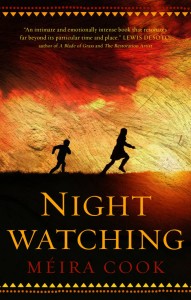 Méira Cook has followed up her award-winning first novel, The House on Sugarbush Road (which was one of my favourite books of 2013) with Nightwatching, also set in South Africa, but this time in the Orange Free State during the 1970s. Though place and time play a more subtle force in this story, which zooms in so close on its characters almost so as to render the backdrop irrelevant. Taking place during one hot summer during which the days seem to stretch forever, and their hours too, the narrative conveys time’s slowness and its intensity, the whole world in slow motion. Motherless Ruthie Blackburn is on the cusp of puberty, her body erupting like a series of volcanoes, and so too her emotions, and yet still she cannot attract the attention of her distant father. So she takes out her rage on Miriam, the Blackburn’s maid and Ruthie’s caregiver, all the while Miriam is consumed by other concerns—her son the political radical, her wayward daughter, the babies that the other maids bring for her to hold on Saturdays before they grow too big and are sent away from their mothers to be raised by extended family. It’s an awkward and tragic status-quo, so that Ruthie has far too much freedom to roam streets, particularly at night, peering into houses and imagining the worlds inside.
Méira Cook has followed up her award-winning first novel, The House on Sugarbush Road (which was one of my favourite books of 2013) with Nightwatching, also set in South Africa, but this time in the Orange Free State during the 1970s. Though place and time play a more subtle force in this story, which zooms in so close on its characters almost so as to render the backdrop irrelevant. Taking place during one hot summer during which the days seem to stretch forever, and their hours too, the narrative conveys time’s slowness and its intensity, the whole world in slow motion. Motherless Ruthie Blackburn is on the cusp of puberty, her body erupting like a series of volcanoes, and so too her emotions, and yet still she cannot attract the attention of her distant father. So she takes out her rage on Miriam, the Blackburn’s maid and Ruthie’s caregiver, all the while Miriam is consumed by other concerns—her son the political radical, her wayward daughter, the babies that the other maids bring for her to hold on Saturdays before they grow too big and are sent away from their mothers to be raised by extended family. It’s an awkward and tragic status-quo, so that Ruthie has far too much freedom to roam streets, particularly at night, peering into houses and imagining the worlds inside.
Curiously for a novel, Nightwatching has a short story’s pacing, immediacy and vivid focus. The plot approaches its tragic end with a sense of inevitability, and in the end it’s not the plot that’s stirring as much as the prose, which creates the novel’s atmosphere and casts a spell that lingers. With the rhythms of its long complicated sentences: “But it was no use, she’d lost the knack, and the sound of the other woman’s name, for once, rang hollow, did not reassure, was not a talisman or a comfort or a cure.” Or, “…and he made his mind a blank, still as a lake with no thoughts to skip across its surface…” And, “Sip shook his head hard as he’d trained himself to do and the past broke up into tiny pieces, the bright colourful mosaics of incredulity and dispassion.”
October 12, 2015
My grandmother’s china
“I have your grandmother’s china for you,” her mother said. “She took good care of it.”
I highlighted this line from a story in Kelli Deeth’s The Other Side of Youth when I read it, the china emblematic of all the ways in which the lives of women my age have failed to progress in the manner that previous generations might have foreseen. All these boxes of china wrapped up in paper and boxed up in basements, and it means nothing now. I grew up in a house with a china cabinet, is what I mean, and it is very unlikely that I will ever have such an item myself, let alone a place to stand it.
Which is not to say that the domestic has no hold, that we don’t give any value to stuff. My Pyrex fixation certainly speaks to that (and I realize now that since the photo in the link was taken, I’ve acquired a set of turquoise Cinderella bowls, and also put a halt on all non-essential Pyrex acquisitions to keep things from getting too out of control). But what I don’t need is a massive collection of dishes and cups to be hauled out on special occasions, just the same way that I don’t need a parlour for afternoon callers. What I like about Pyrex is its usefulness, and then it occurs to me that there is a similar way around the grandmother’s china as well—what if I actually used it?
I have no recollection of ever seeing this china before—I didn’t pay attention to things like plates as a child, particularly if they were patterned with wildflowers. It is also possible that my grandmother didn’t set the table quite so formally when I was coming to visit. Although I do know my own mother’s wedding china intimately. I have no wedding china, but I have a vast collection of cracked and chipped dinner plates that it’s starting to seem shameful to feed my children from, and so I asked my mother if perhaps I could take a look at my grandmother’s china. If we could use them for everyday. Would that be more or less troubling, I wondered, than the plates remaining boxed up until the end of days, or else given away to a consignment store (where I would have totally bought them if I’d happened upon them)?
And so we took them, and now they’re here, unpacked in the kitchen. Some of them need cleaning—the gravy boat is still stained from some dinner more than a decade ago. But for the most part, the plates and cups are in excellent condition. Plates of various sizes, 10 of one, 8 of another, 11 side plates, 11 saucers and 9 tea cups. I wonder what they started with? Only 2 soup bowls—what happened to the rest of them? Or was soup more an intimate course, something best suited to a couple?
Predictably, I’m now a bit obsessed with my grandmother’s china. Who knew? Spode China in the cowslip pattern with a chelsea wicker design. There turns out to be a busy online marketplace for fervid Spode collectors, and now I’m lusting after Spode eggcups and a teapot. I also admire the buttercup pattern (seen here). The former curator of the Spode Museum Trust blogs about all things Spode here (and this is why I love blogs so: there is almost nothing under the sun that has not been blogged about yet). Spode was founded by Josiah Spode in 1770 in Stoke-On-Trent—Josiah Spode was almost an exact contemporary of another pottery-maker called Josiah but instead of a Spode he was a Wedgewood.
We spent this morning at the museum, which re-enlivened my delight in the thingness of things, and it occurs to me how much of my boredom with and dismissal of my grandmother’s things has to do with the idea that this is baggage, something to be carried and put somewhere. (My grandmother never ever put her china in the dishwasher, my mother tells me. We don’t have a dishwasher, so we will quite easily be able to continue in the same tradition.) But with the idea that these things could be used rather than put up on a shelf to be dusted—it changes everything. The best part about things in museums is what they tell us about ordinary life, and so it seems fitting that my grandmother’s china should become part of our ordinary life as well.
Which ensures, I suppose, that each piece will be eventually get broken and never be passed down to anybody, leaving nothing for us to be known by, our ordinary life an enigma to those who come after us, should they even care to wonder. A paradox—the Pompeii exhibit is case in point; does it matter if your frescoes are preserved if you’re dead? But I wonder if it isn’t better to simply live in the moment after all. From a person’s point of view, I mean, if not from that of an archivist.
October 11, 2015
Always thankful…
 But at this moment in particular, I’m thankful for good health, pumpkin soup, sunny days, music to dance to, tea in the pot, too many pies, hometowns and home towns, time, walks, pumpkin festivals where they shoot pumpkins out of cannons, the turkeys who give their lives and also the gourds, those precious moments when the children play together, for harvest, last precious weeks of the farmer’s market, my daughters’ teachers, Crowded House, going to bed early, hoodies, pancakes, groceries, holiday Mondays, for a Canada we recognize, for uppity women, vandals and pot-stirrers all of whom keep it interesting, for the literal pot-stirrers for the gravy, for my children’s incessant chatter, Tabatha Southey, for the people who write the books and the people who sell them, for autumn leaves (the un-ironed ones) and how the sun shines through them, for my mom and my dad and my sister, summer memories, that Taylor Swift songs are so easy to play on my guitar, for my Dyson, for all the kindness, for cheese and beer and wine and ice cream, for precious friendships, Friendsgiving, for Motown music, chestnuts, husbands, lingering baths, and every mortifying thing I’ve ever done that I can no longer remember.
But at this moment in particular, I’m thankful for good health, pumpkin soup, sunny days, music to dance to, tea in the pot, too many pies, hometowns and home towns, time, walks, pumpkin festivals where they shoot pumpkins out of cannons, the turkeys who give their lives and also the gourds, those precious moments when the children play together, for harvest, last precious weeks of the farmer’s market, my daughters’ teachers, Crowded House, going to bed early, hoodies, pancakes, groceries, holiday Mondays, for a Canada we recognize, for uppity women, vandals and pot-stirrers all of whom keep it interesting, for the literal pot-stirrers for the gravy, for my children’s incessant chatter, Tabatha Southey, for the people who write the books and the people who sell them, for autumn leaves (the un-ironed ones) and how the sun shines through them, for my mom and my dad and my sister, summer memories, that Taylor Swift songs are so easy to play on my guitar, for my Dyson, for all the kindness, for cheese and beer and wine and ice cream, for precious friendships, Friendsgiving, for Motown music, chestnuts, husbands, lingering baths, and every mortifying thing I’ve ever done that I can no longer remember.
Happy Thanksgiving!
October 9, 2015
Written and Drawn by Henrietta, A Toon Book by Liniers
 We are in love, besotted, absolutely gaga. I first heard tell of Henrietta—a small brilliant and bookish girl who appears in the Macanudo comics by Argentine artist Liniers—when “Henrietta’s Reading Adventures” appeared in The New Yorker. Then Dan Wagstaff informed me that a Henrietta book was forthcoming from TOON Books, which we’re huge fans of. And that book is Written and Drawn by Henrietta, fun, inspiring and amazingly terrific. We read it together over dinner last night, and just now I had to go retrieve it from Harriet’s bed.
We are in love, besotted, absolutely gaga. I first heard tell of Henrietta—a small brilliant and bookish girl who appears in the Macanudo comics by Argentine artist Liniers—when “Henrietta’s Reading Adventures” appeared in The New Yorker. Then Dan Wagstaff informed me that a Henrietta book was forthcoming from TOON Books, which we’re huge fans of. And that book is Written and Drawn by Henrietta, fun, inspiring and amazingly terrific. We read it together over dinner last night, and just now I had to go retrieve it from Harriet’s bed.
Written and Drawn by Henrietta is a story about the pleasures and frustrations of the creative process. Young readers will be inspired by Henrietta’s creation to make an attempt at their own literary masterpiece (and won’t be intimidated either, with Liniers’ rudimentary-looking Henrietta-style). They will also benefit from practical advice Henrietta offers along the way:
Creating art is not without its challenges and pitfalls, and Henrietta contemplates these as well.
But the narrative is driven primarily by her wonder and her excitement at the story she is creating (“I’m drawing really fast because I want to see what happens next…”) and the reader will be inspired to begin her own creation on Henrietta’s coattails.
…Or at least I’d like to meet the kid who wasn’t.

